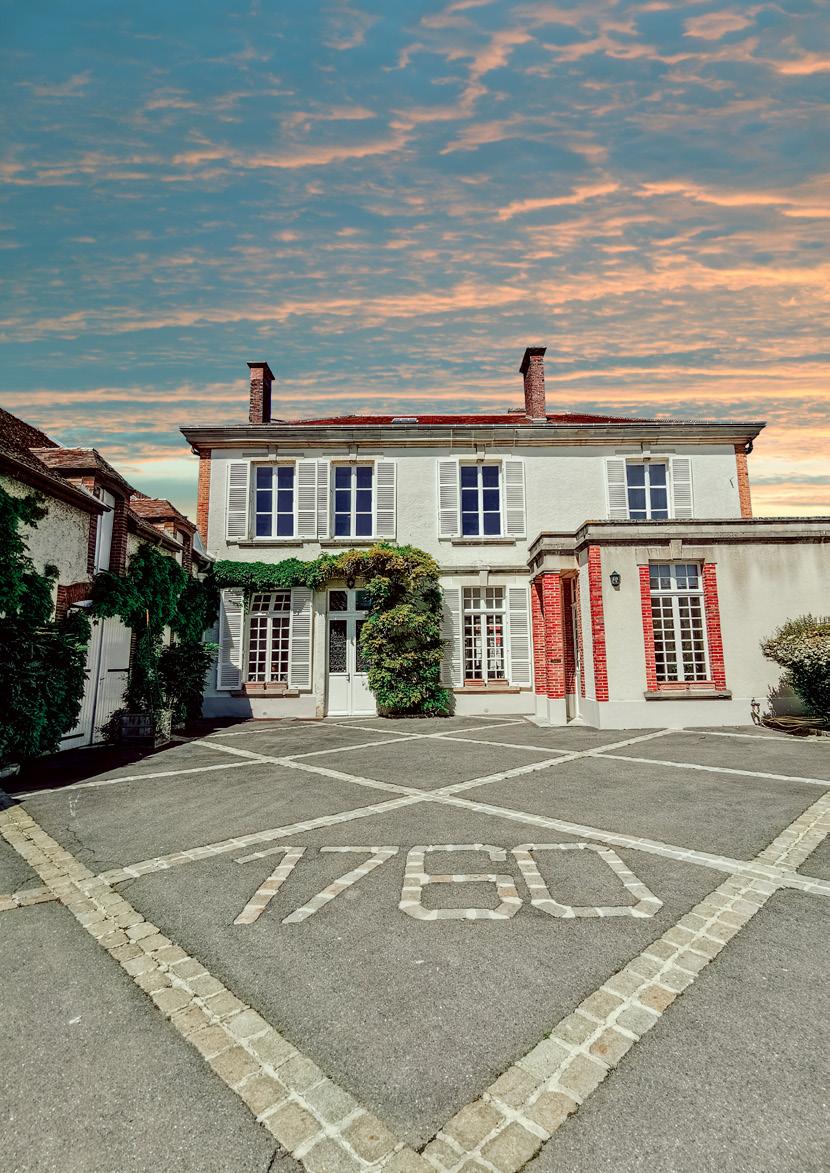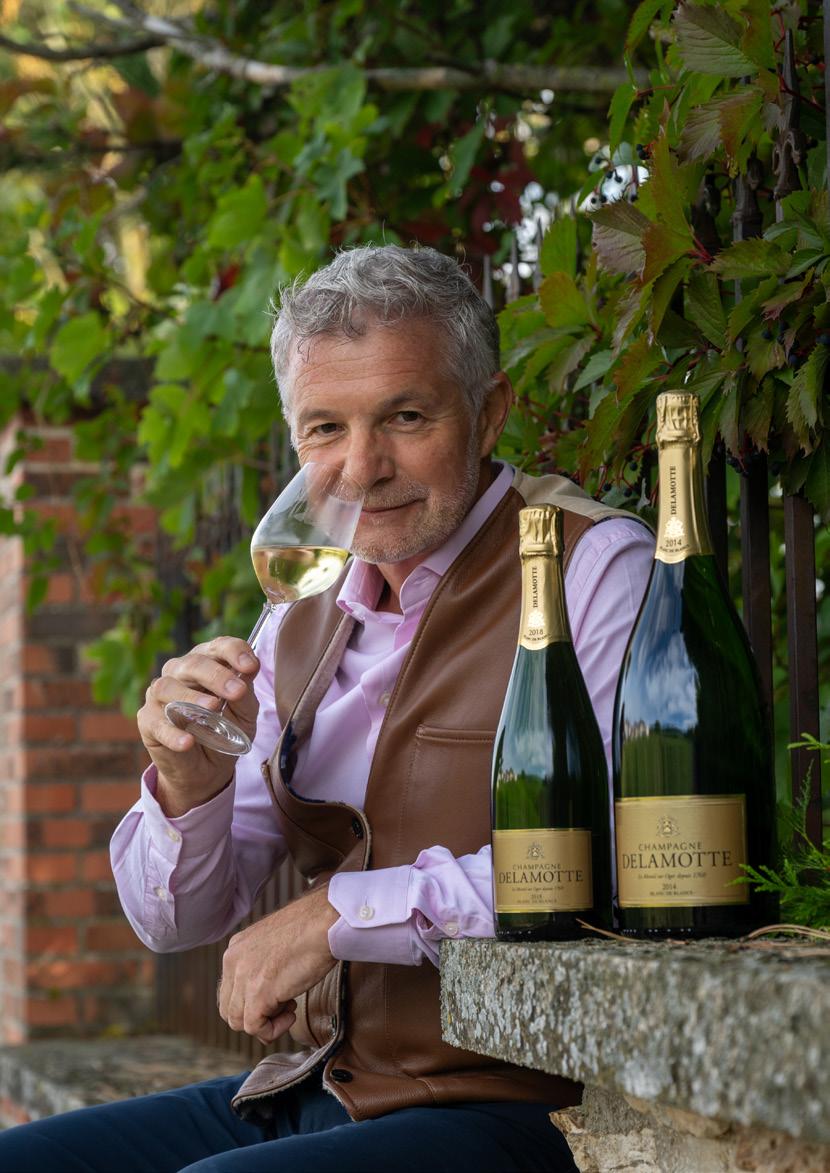
2018 VINTAGE RELEASE
TO CORNEY & BARROW IN THE UNITED KINGDOM
EXCLUSIVE
CHAMPAGNE DELAMOTTE LE MESNIL-SUR-OGER BLANC DE BLANCS 2018

 Delamotte Côte des Blancs ©Hamza Djenat
Delamotte Côte des Blancs ©Hamza Djenat

2
Parcel Delamotte Les Roses in Le Mesnil ©Romain Guittet
INTRODUCTION
‘Un grand champagne est avant tout un grand vin’
DIDIER DEPOND, Président, Champagne Delamotte & Champagne Salon
A great champagne is, first and foremost, a great wine. This fundamental principle defines and propels the legacy of this historic Champagne house. The 2018 vintage, which we are proud to release today, is both testament and tribute to this unwavering standard.
The remarkable yet little-known history of Champagne Delamotte weaves a narrative rich with intrigue, spanning centuries of triumphs and trials. It is the saga of a name that ascended to greatness, then faced the brink of oblivion, only to be resurrected by one of the Champagne world’s most revered figures. Through years of dedication and perseverance, this understated name has quietly reaffirmed its stature as one of Champagne’s greatest houses.
In the heart of the village of Le Mesnil-sur-Oger, hailed by so many as the epitome of Champagne’s grand crus, Delamotte finds its home. Given its heritage and location, Delamotte’s unwavering allegiance to the chardonnay grape should come as no surprise. In local circles, it is affectionately dubbed ‘the other great blanc de blancs’, a nod to its sister house, the illustrious Champagne Salon, with whom it shares not only its elegant headquarters, ownership and leadership, but a certain ethos of poise and refinement.
Quality is sacrosanct, enshrined in a tireless approach to vineyard husbandry and meticulous cellar practices, perhaps even more stringent under the astute stewardship of Didier Depond. He runs this small business with a loyal, long-standing team, just a handful of talented women and men, who oversee every facet of the operation in pursuit of excellence. Yet despite its pedigree, or perhaps because of it, Champagne Delamotte maintains a discreet presence, a rarity for a house of its heritage, prestige and quality. In a milieu awash with momentary glitz and glamour surfacedeep, this unassuming Maison de Champagne has long been the discerning choice ‘pour ceux qui savent’ (‘for those who know’) – surely a fitting motto for Delamotte, should it ever need one.
REBECCA PALMER
April, 2024
3
THE TALE OF CHAMPAGNE DELAMOTTE
The remarkable yet little-known history of Champagne Delamotte weaves a narrative rich with intrigue, spanning centuries of triumphs and trials. It is the saga of a name that ascended to greatness, then faced the brink of oblivion, only to be resurrected by one of the Champagne world’s most revered figures. Through years of dedication and perseverance, this understated name has quietly reaffirmed its stature as one of Champagne’s greatest houses.
Maison Delamotte was founded in 1760 by François Delamotte. Born in 1722 in Reims, he had forged a distinguished career as a military captain and magistrate of considerable standing. He also owned sizeable vineyard holdings in Cumières. Influenced no doubt by his father-in-law, Antoine Bourgongne, a vine-grower in Aÿ who produced champagne under his own name, François decided to do the same, and in 1760 established a House of Vins de Champagne (Wines of Champagne), in a building on the corner of rue Cérès and rue Marmousets, where he lived. The trade name Delamotte Père & Fils was adopted in 1786, when François’ elder son Alexandre joined forces with his father to help develop the now burgeoning family business.
François also had another son, Nicolas Louis Delamotte, born in 1767. A natural leader and gregarious in personality, Nicolas Louis had earned himself the rather impressive title of Knight of the Order of Malta. After the Napoleonic conquest, the Order was dissolved and in 1798, Nicolas returned to the family fold. His arrival led to the creation of Delamotte’s distinctive trademark, incorporating the eight-pointed cross of the Order.
1798 also marked Nicolas Louis’ wedding to MariePierrette Barrachin, whereupon he became known by the name Chevalier Delamotte Barrachin. Successful in business and influential in the wider trade, Nicolas Louis rose to become President of the Chamber of Commerce in Reims. It was in this capacity that he oversaw arrangements for the coronation of Charles X on 29th May 1825. He was subsequently made a Chevalier of the Legion of Honour.
Nicolas Louis’ friendship with a certain Jean-Baptiste Lanson was to prove significant to the history and evolution of Champagne Delamotte. While the Lanson name is well-known these days in the context of Champagne, few realise its history began with Delamotte.
Jean-Baptiste Lanson was born in 1777 to Claude Henri Lanson and Marie-Nicolas Legros, wealthy farmers in the Ardennes. In the bloody events of 1792-3, the teenage Jean-Baptiste fled over the Rhine and into Germany. During this period, he studied German and the rudiments of commerce. In the early 1800s he was to return to France, got married and started a family, moving to Reims in 1808. He forged a distinguished career as a civil servant, moving through the ranks at Reims City Hall, and becoming a high-profile public figure. Highly respected and sought-after in business and society alike, he held key positions on a number of trade committees and councils and was later to serve as Deputy Mayor of Reims, earning himself the title of Chevalier of the Legion of Honour for his contribution to public service.
Moving in similar circles, Nicolas Louis Delamotte and Jean-Baptiste Lanson came to know each other well. In 1828, Nicolas Louis offered his friend a minority partnership in the family business, and Jean-Baptiste accepted. After Nicolas Louis died in 1837, his widow Marie-Pierrette and Jean-Baptiste co-managed the company, trading under the name Veuve DelamotteBarrachin.
4

5

6
Delamotte House ©Hamza Djenat
As time went on, Jean-Baptiste assumed increasing operational responsibility and in 1856, when MariePierrette died without heir, he assumed full control. Re-establishing the business entirely, he abandoned the Delamotte name in favour of Lanson Père & Fils. Thus, after almost one hundred years, the great Delamotte name seemed lost forever.
Or perhaps not. As so often happens, a woman will arrive on the scene to save the day! Delamotte’s saviour was Marie-Louise de Nonancourt, whose lineage and decisions were to prove instrumental for the future not just of Champagne Delamotte, but also of Champagne Salon and the owner today of both houses: Champagne Laurent-Perrier.
Marie-Louise de Nonancourt was born Lanson, a descendant of Jean-Baptiste himself, and had two brothers Victor and Henri, who were to become key figures in the Lanson business. In 1924, Marie-Louise was widowed prematurely. Facing a precarious financial future, she plunged her energies into the family business. In a moment of serendipity, she was to learn that a small, tumbledown champagne house in Tours-sur-Marne was for sale, its owner having died without heir. Anxious to secure future prosperity for her sons, she seized the opportunity to buy it. The house was called LaurentPerrier. At the same time, Marie-Louise inherited the rights to the House of Delamotte, via the female line.
The business grew, so much so that in 1927, eyeing continuity of supply, Marie-Louise made the decision to transfer the house of Delamotte to Le Mesnil-sur-Oger, in the heart of the Côte des Blancs – an entirely logical move given Delamotte’s predilection for chardonnay. Over the following decade and beyond, Delamotte’s fortunes continued to grow exponentially under the astute and dynamic custodianship of this extraordinary woman. She even kept the operations running through the second World War, though her sons Charles and Bernard then assumed greater roles in the businesses.
For forty years, from 1948 to 1988, Charles de Nonancourt continued to build the House of Delamotte based on the concept of premium quality (today this would no doubt
earn the marketing moniker of ‘boutique operation’), while his older brother Bernard took the reins at Laurent-Perrier. Bernard – a man of enormous charisma, intelligence and phenomenal work ethic - was to transform LaurentPerrier into one of the most important and successful houses in the entire champagne region. In 1988, Bernard bought Champagne Delamotte and integrated it into the Laurent-Perrier group. Just a few months later, he was able to realise a long-held dream - an emotional milestone that merits a chapter of its own! – in acquiring at long last the tiny Champagne Salon, Delamotte’s neighbour in Le Mesnil-sur-Oger.
This is how the destinies of Salon and Delamotte came to be entwined, the story of which is little known and rarely told. Today, these two exceptional producers operate as sister houses, sharing offices and facilities in the very same historic townhouse in Le Mesnil-sur-Oger, bought by Marie-Louise de Nonancourt so many years before.
The fact that Champagne Delamotte exists today, is a tribute to the generations of men and women who have upheld a legacy spanning three centuries - François Delamotte and his sons Alexandre and Nicolas Louis; Nicolas’ widow Marie-Pierrette Barrachin and their great friend Jean-Baptiste Lanson; his descendant Marie-Louise de Nonancourt and her sons Charles and Bernard.
Today, one man carries that mantle, and this is Didier Depond, the dynamic Président of Champagne Delamotte and Champagne Salon. Considering Depond’s ancestors were all vine growers, it is perhaps no coincidence that he would come to build a career in the wine world. Having completed commercial studies, in 1986 he joined Laurent-Perrier in a sales role, moving through the ranks to become Head of Marketing in 1994. Just three years later in 1997 he was made Président of both Champagne Delamotte and Champagne Salon. A close mentee of Bernard de Nonancourt for many years, Didier cites the enormous influence of le grand BN (‘the great BN’) on his career. Like him, one of the champagne region’s most passionate advocates, hard-working and high-achieving, Didier continues to forge the reputation and image of Champagne Salon and Champagne Delamotte worldwide.
7
2018
VINTAGE NOTES
Great wines are often forged in epic extremes (or extreme epics?) and Delamotte 2018 was to prove no exception.
It was winter, when the saga first began. Gentle rains, initially welcome to replenish much-depleted reserves, turned into tempestuous deluges of biblical proportions. Much to the astonishment of growers, in Champagne and beyond, the rainfall was so heavy and persistent that soils reached saturation point, nowhere more so than in the Côte des Blancs. In Le Mesnil-sur-Oger particularly, Delamotte’s chalky soils – naturally moisture-retentive – absorbed quite staggering volumes of water (for the enthusiasts among us: up to 600 litres per cubic metre!) These were to prove something of a liquid windfall, in the months to come.
Following a frosty February and a March that couldn’t quite make up its mind between the snowy vestiges of winter and inklings of spring, the mercury started to rise, coaxing the slumbering vines into action. As the spectre of winter faded, and vignerons settled into the pleasant rhythms of spring, an uninvited guest crashed the party – an early heatwave. Powered by luminous sunshine and the swell of warmth, the vineyards surged dramatically into overdrive, so much so that some chardonnay vines began flowering as early as 30th May –virtually unheard of.
As spring sped into summer and the days grew long, the sun blazed with unyielding intensity. Its scorching embrace persisted, plunging the region into a drought more extreme even than the infernal summer of 2003. As the earth baked and cracked, temperatures torrid and the once resplendent sun now just relentless, desperate growers longed for those early rains, now a distant memory. In many areas, giddy vines wilted alarmingly or shut down completely in a wasteland of arid heat. Yet, in the Côte des Blancs, something extraordinary was afoot. Beneath the desiccated veneer of sun-baked earth lay a secret reservoir - the legacy of the winter rains and a lifeline for the vines, sustaining them through the remainder of the season.
Unsurprisingly given such exceptional conditions, harvest started early, Le Mesnil-sur-Oger leading the charge on 27th August. The crop was nothing short of remarkable in quality and quantity, the grapes not only pristine but unprecedented in size and weight (chardonnay bunches tipping the scales at an impressive 175g!). Rich in sugars, they promised a potential alcohol content of over 10%, with balancing acidities. This reminded many of the legendary 1976 vintage (also a famous heatwave summer) but with an additional dimension of fruit… a winemaker’s dream come true?
8
 Didier Depond et ses chardonnays
Didier Depond et ses chardonnays
9
©Leif Carlsson

10
WINEMAKING
Delamotte’s vintage champagnes are the ultimate celebration of its distinctive terroirs, produced only when the harvest has yielded fruit of the requisite profile, style and quality.
Delamotte Blanc de Blancs 2018 is only the fourth iteration to draw on all six grand crus of the Côte des Blancs. This blend, a long-held vision of Didier Depond himself, made its debut with the 2008 vintage, when Chouilly and Oiry joined the original line-up of Le Mesnil-sur-Oger, Avize, Cramant and Oger.
The blend marries grapes from Delamotte’s prized parcels in Le Mesnil with those from a number of trusted vignerons across the Côte, faithful suppliers to Delamotte for generations. While the precise proportions of each grand cru will change subtly according to the unique conditions of the vintage and its fruit – guarded secrets known solely to Delamotte’s technical director and to Didier himself –the overarching stylistic objective remains constant: to encapsulate and celebrate the quintessence of the Côte des Blancs, in all its profound depth and ethereal lightness, its tension of richness and finesse.
Every grand cru imparts its unique personality to this cuvée, transcending the sum of the parts. Predictably, Le Mesnil-sur-Oger assumes the spotlight with its laser-beam of minerals, seamless purity and delicate saline notes. Avize, the epitome of elegance, tempers the opulent fruit of Oger, while Cramant brings its diaphanous veil of smoke and texture of slipper-satin. Chouilly lengthens and smooths the palate, while Oiry lends its delicate acid lacework and understated sensuality.
The grapes from each vineyard undergo a slow, gentle pressing in a Willmes press, with only the finest fractions selected. The primary fermentation takes place at precise temperatures in stainless steel tanks, followed by complete malolactic fermentation. After the prise de mousse, the wines rest sur lattes in Delamotte’s cellars for several years, to acquire aromatic and structural complexity through the gradual process of autolysis.
The bottles of 2018 were disgorged in October 2023, after just over 4.5 years on the lees – an ageing period appropriate for this radiant, riper year, by comparison with recent higher-acid vintages. As always, dosage is discreet, in the interests of harmony and longevity – just 5g/l.
11
TASTING NOTE
DELAMOTTE BLANC DE BLANCS 2018
Elegant and ethereal, Delamotte Blanc de Blancs 2018 will enchant with its refined grace. Disgorged in October 2023 after over 4.5 years on its lees, the wine is fresh and agile.
The classic Delamotte signature is unmistakable already, even in youth (last tasted in March 2024): the fragrance of jasmine, fresh ginger, the scent of stone after rain; the exquisite mousse of minuscule filigree bubbles gliding effortlessly, weightlessly across the palate. Luminous yet understated, the palate layers fresh orchard fruits with light crème fraîche and those familiar fine, chalky acids.
For those with the discipline, put a few cases in the cellar. Carefully stored, the wine will continue to refine and hold for a further 10-15 years. Didier Depond gives his ‘official’ drinking date to 2045.
Corney & Barrow Score 18.5
Recommended drinking from 2024 - 2039+
£330/Case of 6 bottles, in bond UK
Available from Spring 2024
Tasting Guide
Our tasting notes provide full details but, at your request, we have also introduced a clear and simple marking system. We hope these guidelines assist you in your selection. For the benefit of simplicity, wines are scored out of 20. We will often use a range of scores (e.g. 16.5 to 17) to indicate the potential to achieve a higher mark. When a ‘+’ is shown it adds further to that potential. Wines from lesser vintages will, inevitably, show a lower overall score.
Wines are judged, in a very broad sense, against their peers. Why? Well, you cannot easily compare a Ford with an Aston Martin, other than they are both cars and have wheels. It is not that different with wine. A score is a summary only. The devil is in the detail, so please focus on the tasting notes and, as always, speak to our sales team.
12

13

1 Thomas More Street London
E1W 1YZ
T +44 (0)20 7265 2400 sales@corneyandbarrow.com
1 Rous Road Newmarket, Suffolk
CB8 8DH
T +44 (0)1638 600 000 newmarket@corneyandbarrow.com
8 Academy Street, Ayr
Ayrshire, Scotland
KA7 1HT
T +44 (0)1292 267 000 ayr@corneyandbarrow.com
LONDON EAST ANGLIA EDINBURGH NORTH OF ENGLAND @corneyandbarrow @corneyandbarrow
Oxenfoord Castle by Pathhead Midlothian, Scotland
EH37 5UB
T +44 (0)1875 321 921 edinburgh@corneyandbarrow.com
4 Park Square East Leeds
LS1 2NE
T +44 (0)1133 400 380 northofengland@corneyandbarrow.com
SINGAPORE
70 Anson Road
#07-01 Hub Synergy Point Singapore 079905
T +65 6221 8530 singapore@corneyandbarrow.com
INSTAGRAM FACEBOOK AYR
X @corneyandbarrow
CONTACT US Our Locations Online www.corneyandbarrow.com


www.corneyandbarrow.com


 Delamotte Côte des Blancs ©Hamza Djenat
Delamotte Côte des Blancs ©Hamza Djenat




 Didier Depond et ses chardonnays
Didier Depond et ses chardonnays



